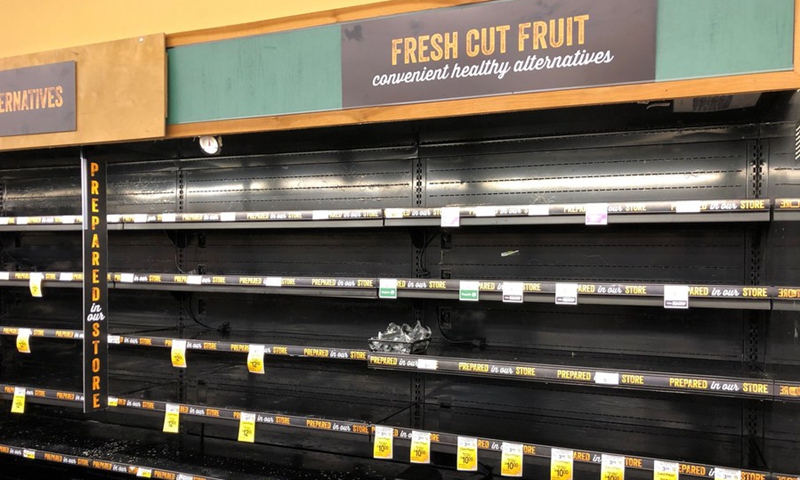U.S. should fix its energy delivery system in caution against future disasters: media

Photo taken on Feb. 19, 2021 shows empty fruit shelves at a Tom Thumb grocery store in Plano, northern suburban city of Dallas, Texas, the United States.(Photo: Xinhua)
The United State's energy delivery system, not just in Texas but everywhere, needs a radical overhaul if it is to withstand future shocks and play the role that President Joe Biden has assigned it in the battle against climate change, said The New York Times on Monday in an Opinion article titled "The Lessons of the Texas Power Disaster."
"The simple truth is that the state (Texas) was not prepared for the Arctic blast. A few wind turbines froze up, but the main culprits were uninsulated power plants run by natural gas. In northern states, such plants are built indoors; in Texas, as in other Southern states, the boilers and turbines are left exposed to the elements," said the article.
Last week's power failures in Texas had left a number of people dead and millions without power or potable water, sometimes for days, according to the article contributed by The Editorial Board, a group of opinion journalists whose views are informed by expertise, research, debate and certain longstanding values. It is separate from the newsroom.
"There are two lessons here to be absorbed and acted on. First, the country's energy systems must be robust enough to withstand whatever surprises climate change is likely to bring. ... The scientific connection between climate change and extreme cold is not as well established, but it would be foolish to assume that it is not there," it said.
"If building resilience is one imperative, another is making sure that America's power systems, the grid in particular, are reconfigured to do the ambitious job Mr. Biden has in mind for them -- to not just survive the effects of climate change but to lead the fight against it," it added.
Meanwhile, the current predicament will require from Congress a clear-eyed look at the climate-driven calamities that have beset California, the Caribbean and, most recently, Texas, according to the article.
"It will also require an honest accounting of their great cost, in both human and financial terms, and of the need to guard against their recurrence in the years to come," it added.
According to U.S. Energy Information Administration, electricity in the United States is generated using a variety of resources and technologies. The majority of electricity is produced using conventional sources such as natural gas, oil, coal and nuclear.
Larger electricity networks are created through the interconnection of local grids, which are linked for commercial and reliability purposes. At the highest level, the network covering the lower 48 states is comprised of three major interconnections (East, West and Texas), functioning predominantly independently of one another with limited exchanges of power between them.
